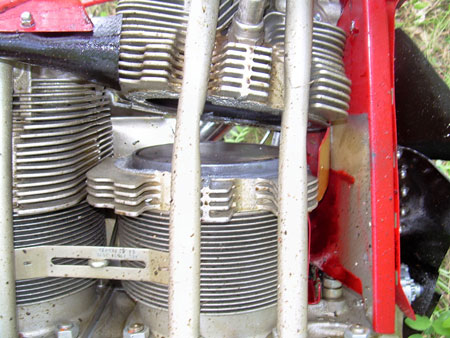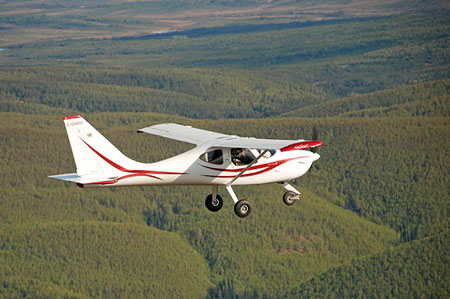Engine Power Loss-Forced Landing
Amateur-Built Glastar C-GMDP
Chetwynd, British Columbia, 6 nm SSW
The Transportation Safety Board of Canada (TSB) investigated this occurrence for the purpose of advancing transportation safety. It is not the function of the Board to assign fault or determine civil or criminal liability. This report is not created for use in the context of legal, disciplinary or other proceedings. See Ownership and use of content. Masculine pronouns and position titles may be used to signify all genders to comply with the Canadian Transportation Accident Investigation and Safety Board Act (S.C. 1989, c. 3).
Summary
The amateur-built Glastar (registration C-GMDP, serial number 5112) was on a pleasure flight from Yellowknife, Northwest Territories, to Kelowna, British Columbia, with two pilots on board. At approximately 1401 Pacific daylight time, shortly after passing Chetwynd, British Columbia, a severe power plant vibration and loss of power was experienced. The engine power was reduced to 1000 rpm and a forced landing into a field was attempted. On short final, the aircraft struck a power line and veered off course to the right, where it struck trees and rising terrain. The pilot in the left seat received non-life threatening injuries. The pilot in the right seat was fatally injured. There was no emergency locator transmitter (ELT) signal and no fire. The switch on the ELT was found in the OFF position.
Other Factual Information
The aircraft refuelled at Dawson Creek, British Columbia (B.C.) and departed Dawson Creek near its maximum gross weight and within the centre of gravity limits. Enroute, it descended from 5500 feet above sea level (asl) to 3500 feet asl due to turbulence. When the vibration occurred, the pilot flying in the left-hand seat gave control to the more experienced pilot in the right-hand seat. There were no reported issues with aircraft controllability.
After severing the power line and changing direction, the aircraft hit the tops of a row of trees and narrowly missed a house and garage. It then struck trees on rising terrain. Both wings were folded back and various surfaces were torn off.
The accident site was beside Highway 97, 6 miles south-southwest of Chetwynd, B.C. at North 55 37' 13.825", West 121 34' 27.710" at approximately 1800 feet asl. The Chetwynd weather at 1400Footnote 1 was wind south at 9 km/h, gusting to 30 km/h, 30 statute miles (sm) visibility, high broken cloud, and temperature of 26°C.
Examination of the wreckage revealed that the number two cylinder head had separated from the base (See Photo 1) and the crankshaft was severed at the propeller flange. The engine had 212 hours total time since new (TTSN) when the failure occurred.
The engine crankshaft sheared at the propeller hub and the propeller was found embedded in a tree at the accident site (See Photo 2). The propeller was nicked and scuffed in a manner consistent with striking the severed power line.
The pilot in the left-hand seat held a Canadian private pilot licence valid for single-engine land and sea planes. The pilot in the right-hand seat held a Canadian ultra-light aeroplane licence and recreational pilot permit issued on the basis of a Swiss private pilot licence for land and sea aeroplanes with the following restrictions: limited to one passenger, day VFR only, valid only in Canadian airspace, and eyeglasses must be available. He also had experience as a helicopter pilot. Both pilots were certified and qualified for the flight in accordance with existing regulations.
The Glastar has a high-wing, two seats side-by-side, tricycle landing gear, and a 190-horsepower Aero Sport Power O-360-A2A engine (serial number 0808-SPE). The aircraft was well-equipped and maintained (see Photo 3).
The Aero Sport Power O-360-A2A engine is assembled by Aero Sport Power based in Kamloops, B.C. These engines are built using parts purchased from various suppliers who hold Parts Manufacturing Authority (PMA) granted by the United States Federal Aviation Administration (FAA). The Aero Sport Power O-360-A2A can be described as a non-certificated clone of the Avco Lycoming O-360-A2A engine, which holds type certificate number E-286 issued by the FAA.
PMA parts may be sold with certification for use on type-certificated engines. The Aero Sport Power O-360-A2A engine is sold to amateur builders as an experimental engine, and no certification is required for this category by Transport Canada (TC).
Aero Sport Power used cylinders manufactured by Engine Components Inc. (ECi). At the time of the build up, Aero Sport Power installed pistons that increased the engine compression ratio from 8.5:1 to 9.2:1.
The failed cylinder assembly was sent to the TSB Laboratory for examination. A fracture surface analysis of the number two cylinder and sheared crankshaft was completed. The crankshaft propeller flange showed signs of minor hydrogen embrittlement. The sheared crankshaft was determined to be from overload fracturing due to impact. The minor hydrogen embrittlement was not causal to the accident.
In the fall of 2008, the FAA issued Airworthiness Directive (AD) 2008-19-05 regarding ECi cylinder assemblies installed on the Lycoming engines. The AD addressed a manufacturing defect that caused the cylinder head to separate from the base. It did not, however, address engines with increased compression ratios. Engines that are not type-certificated, such as the Aero Sport Power engines, were not mentioned in the AD. The cylinder head failure fracture surfaces were typical of fatigue failures addressed by this AD.
Prior to the issuance of AD 2008-19-05, ECi issued Mandatory Service Bulletin (MSB) 08-1. This MSB called for the inspection and replacement of the faulty cylinders by 350 hours total time in service.
On 29 April 2009, Aero Sport Power advised the owners of the occurrence aircraft by e-mail that three of their cylinders were affected by the ECi MSB. The surviving owner/pilot was aware of neither AD 2008-19-05 nor the MSB regarding the faulty cylinders. He also was not involved with the building of the aircraft. The deceased owner/pilot had built the aircraft. Aircraft records do not indicate compliance with the AD or MSB. However, records show that differential pressure checks, required by the AD, were carried out. None of the differential pressure checks resulted in values that would have required further inspection and action in accordance with the AD. These checks were carried out 22 hours prior to the failure, during the last annual inspection and service.
TC issues notification of ADs to owners and operators of private and commercially registered aircraft with type-certificated airframes, engines, and propellers. However, Canadian Aviation Regulations (CARs) Standard 593 - Airworthiness Directives, 593.01 - Application contains the following information notes:
- The Minister will not issue Airworthiness Directives (ADs) against amateur-built, owner-maintained or ultra-light aircraft.
- ADs are issued against certified aeronautical products independently of the aircraft type concerned. Where an AD is issued to identify an unsafe product, this condition is likely to exist regardless of the aircraft type in which the product is installed. Therefore, even though such ADs would not be mandatory on amateur-built, owner-maintained and ultra-light aircraft, owners should take these ADs into account.
The TC Continuing Airworthiness Web Information System (CAWIS) is a Web site where a user can enter a Canadian registration mark and receive a list of all the ADs applicable to that aircraft, its engine, and propeller if it has a type certificate.Footnote 2 The owners of the accident aircraft registered the engine as an Avco Lycoming O-360-A2A, which is type certificated. This was done as a means of obtaining AD information that might affect their engine. However, they were required to initiate the query in order to find out whether or not a new AD had been issued. When the registration C-GMDP was entered into the database, numerous ADs related to the engine were listed, including 2008-19-05. Since the accident, Transport Canada has changed the accident aircraft's information in the CAWIS database to reflect the Aero Sport Power engine. No ADs are listed for that engine.
According to the TC Aircraft Registration Database, there are approximately 33 000 aircraft registered in Canada. One-third of these (10 428) are non-type-certificated. It is believed that some of these aircraft are projects that have never flown or accident aircraft that have never been deregistered. Aircraft registrations in this sector of aviation continue to grow each year.
There is no regulation that restricts the operation of these aircraft over built-up areas, except for the initial operating restrictions required during the first 25 hours of flight.
Analysis
The failure of the cylinder head occurred at 212 TTSN, well in advance of the 350-hour limit set out in the AD. Compression checks completed 22 hours prior to the accident failed to detect a problem. This is not uncommon because compression tests will not necessarily detect an impending failure. It is possible that the premature failure of the cylinder head was due to the increased compression ratio of the engine.
The surviving owner/pilot was unaware that there was a critical AD that affected their engine. The deceased partner was notified by e-mail of the MSB, which was referenced in the AD, and he performed the required differential checks. There was plenty of time remaining before reaching the 350-hour limit on the cylinder head.
TC does not issue ADs for non-type-certificated aircraft, propellers, engines, and equipment; nor do they notify the owners of these aircraft of ADs that could adversely affect them.
The number of amateur-built, owner-maintained, and ultra-light aircraft is growing. The onus is on the owners of these aircraft to ensure airworthiness. Without additional system safeguards, there is a greater risk that these aircraft will not be properly built and maintained.
These aircraft often operate in the vicinity of populated areas, thereby increasing the risk to the public and to property.
The following TSB Laboratory report was completed:
- LP 085/2009 – Examination of Cylinder and Crankshaft
This report is available from the Transportation Safety Board of Canada upon request.
Findings
Findings as to causes and contributing factors
- The failure of the number two cylinder caused the engine to lose power.
- During the attempted forced landing, the aircraft struck power lines, control was lost, and the aircraft collided with trees and terrain.
Finding as to Risk
- Non-type-certificated aircraft owners are not advised of, nor are the owners required to comply with, Airworthiness Directives (ADs) that are potentially critical to aviation safety. This greatly increases the risk that important airworthiness issues may go unaddressed by the amateur-built community.
Other findings
- The population of amateur-built, owner-maintained, and ultra-light aircraft is growing. This increases the risk to the public and to property if they are not properly designed, produced, and maintained.
- Evidence of minor hydrogen embrittlement was found in the crankshaft. While not causal to the accident, it increases the risk of material failure over time.
Safety Action Taken
Aero Sport Power
Aero Sport Power has notified all engine owners potentially affected by Airworthiness Directive (AD) 2008-19-05 and those who have increased the compression ratio.
Recreational Aircraft Association of Canada
The Recreational Aircraft Association of Canada issued a notification to its members regarding AD 2008-19-05 and the possible effect of the increased compression ratio. This notification also reminded members how to search for ADs by aircraft registration using the Transport Canada Continuing Airworthiness Web Information System (CAWIS) Web site.
Danbury Aerospace
Danbury Aerospace, the parent company of Engine Components Inc. (ECi), has elected to limit the compression ratio of cylinders sold in engine kits.
This report concludes the Transportation Safety Board's investigation into this occurrence. Consequently, the Board authorized the release of this report on .


